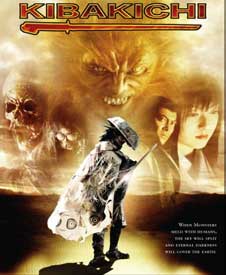 In the opening pre-credits scene Kibakichi (2003) presents a solid, classical-style chambara or swordplay encounter as a group of bandits leap out intent on killing a passing wanderer.
In the opening pre-credits scene Kibakichi (2003) presents a solid, classical-style chambara or swordplay encounter as a group of bandits leap out intent on killing a passing wanderer.
The gloomy wanderer kills all of them. The scenes along the grassy path, the choreography, the costuming, the ultra-cool wandering swordsman, all seem to have stepped out of chambara of the 1960s. It momentarily gives one hope that this will be a seriously played film with elegance instead of kitsch.
Immediately after the credits we are introduced to the first fairy tale monsters, including the turtle-like kappa that leap out of the water to confront our wanderer. From that point on it gets increasingly horror-fantasy oriented. This stuff is loads of fun, even though it completely spoils the serious demeanor the film starts out with.
Where it fails is with the character of Kibakichi being a werewolf. His costume is just plain ridiculous, like he has donned a sasquatch suit or Wookie costume rented for Bon Odori (Japanese Halloween), this in spite of the fact that the majority of the director's film experience has been as special FX man.
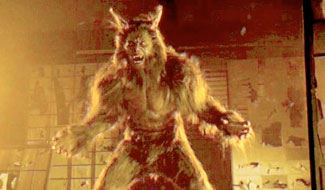 There would have been more strength to this film if Kibakichi retained the wanderer costume & had done mortal battle against yakuza, samurai, & demons. There would have been more strength to this film if Kibakichi retained the wanderer costume & had done mortal battle against yakuza, samurai, & demons.
By leaping about in the sasquatch suit, the film is reduced mainly to child's stuff. Although again, enjoyable child stuff in its way.
The second unfortunate ingredient is gunplay. Shoot-outs pale compared to the swordplay. And being set in an historical period when Japan had pretty much "given up the gun," part of the romantic greatness of such action dramas is the manner by which the sword dominates, & duels are close-up & personal.
By comparison, the use of machine guns & hand grenades in medieval Japan is more goofy than enthralling.
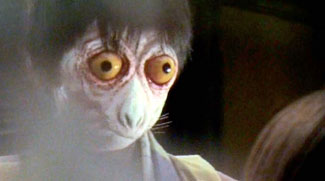 Putting the chief bad guys in Matrix leather coats likewise throws the viewer out of the tale with big reminders that this is just a dumb corny film for cheerful dunderheads too drunk to care if stories make sense or not. Putting the chief bad guys in Matrix leather coats likewise throws the viewer out of the tale with big reminders that this is just a dumb corny film for cheerful dunderheads too drunk to care if stories make sense or not.
Deeply flawed though it is, I appreciated the effectiveness of keeping a straight face & treating these fairyland monsters not as jokes but as a culture unto themselves, as being as capable of heroism as are humans, if not more capable.
They are creatures to be taken as seriously as any human characters would've been. Any fool can make sword & sorcery look comical. But to treat of the fantastic with conviction is has at least the potential, whether or not achieved, of being great stuff.
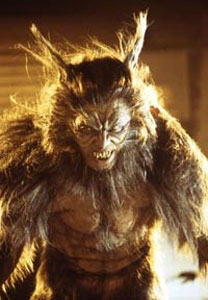 The primary set-up is how a clan of Yokai (ancient demons) have more or less been given a rental agreement over a small village, from gangster & samurai interests that will not in the end serve the needs of the Yokai after all.
The primary set-up is how a clan of Yokai (ancient demons) have more or less been given a rental agreement over a small village, from gangster & samurai interests that will not in the end serve the needs of the Yokai after all.
The demons, long set-upon by humans who hate demons, believe they may finally be able to have a place of their own to live in peace. But the yakuza & samurai are not to be trusted.
Dour Kibakichi would like to live in the human world & fit in, but knows he cannot. Being a werewolf, he has great empathy for the demons. He naturally sides with them in the final battle.
The DVD box says Kibakichi is a samurai werewolf, but he is not a samurai. Many English language reviewers repeated this error. Kibakichi is a one-sword man (not a two-sword man as would be a samurai). He's an unlanded peasant travelling in the criminal underground among gamblers & gangsters.
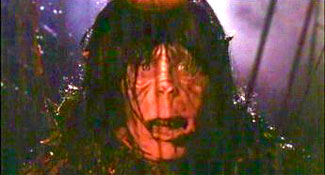 The ultimate film about such wanderers is Kon Ichikawa's 1973 Matatabi (Wanderers, 1973), about three young toseinin or adventuring peasants who don flat-topped straw hats & broad capes just like Kibakichi's. The ultimate film about such wanderers is Kon Ichikawa's 1973 Matatabi (Wanderers, 1973), about three young toseinin or adventuring peasants who don flat-topped straw hats & broad capes just like Kibakichi's.
Such wanderers thrust one sword through their obi belt -- as opposed to the two-swords of samurai -- & take off along the medieval highways pursuing the life of gamblers, either of the chivalrous type or just petty crooks.
In Japanese pulp literature & escapist cinema, it is a given or a romantic fiction that some of these wanderers had fighting skills comparable to those of samurai, & gambling skills sufficient to keep them more or less honest knight errants rather than thieves or thugs.
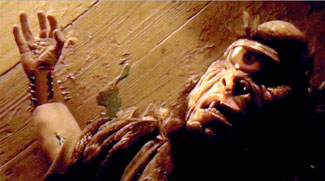 Such is the nature of brave, skillful Kibakichi, though the wanderers of Kon Ichikawa's film were more realistic thus neither skillful as fighters nor lucky as gamblers. Such is the nature of brave, skillful Kibakichi, though the wanderers of Kon Ichikawa's film were more realistic thus neither skillful as fighters nor lucky as gamblers.
Kibakichi stays at a gambling house because such wanderers would receive "lodging for the night" in trade for obligation to the house. Such a man would then have a moral debt to assist the household if something unfortunate developed, which in tales of wandering gamblers always happens.
If the concept of the Wanderer class is unfamiliar to western viewers, how wildly unfamiliar will be the Yokai.
They are drawn from medieval folklore & literature & from a type of summer entertainment on kabuki stage and funhouse attractions that resemble our own Halloween events, but for the Festival of Ghosts (Bon Odori). The supernatural creatures are supposed to inflict a welcome "chill" in the summer season, when Bon Odori occurs.
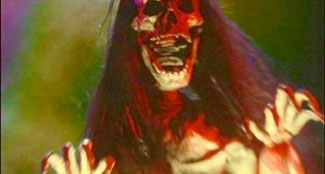 Films about Yokai are a genre unto themselves that go back to beginnings of Japanese cinema, & had their first big rage of popularity in the 1950s & 1960s of black & white kaidan (weird) & yokai (demon) movies. Films about Yokai are a genre unto themselves that go back to beginnings of Japanese cinema, & had their first big rage of popularity in the 1950s & 1960s of black & white kaidan (weird) & yokai (demon) movies.
Influences of western horror cinema displaced yokai films by the 1970s. There has been a minor resurgence of B-budget yokai films in recent years, but they are still a minority of films.
I dislike dubbed voices in foreign films. The sound of Japanese language & of Japanese vocal inflection is very much an essential part of a period drama, so as always I watched the English subtitle version.
But for a couple minutes I accidentally had the dub version turned on & must say, it's pretty good dubbing, so for viewers who hate to have to read a film, Kibakichi should be effective either way it is watched, & it's not quite a good enough film for it to feel essential that it be appreciated as it was intended for sound.
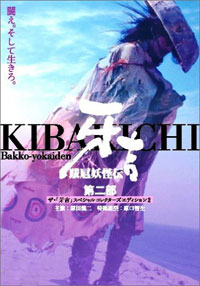 Ryuuji Harada returns as the titular antihero in Kibakichi 2 (2004), still angst-driven & miserable, still a great swordsman, inescapably a despised yokai monster, & more than ever wasted in a story that just didn't need to be quite so damned kitschy. Ryuuji Harada returns as the titular antihero in Kibakichi 2 (2004), still angst-driven & miserable, still a great swordsman, inescapably a despised yokai monster, & more than ever wasted in a story that just didn't need to be quite so damned kitschy.
Yukihime or Snow Princess (Yoko Kamon) is one of the monster-slaying demigods. She is the only one who regrets killing monsters for no better reason than their difference.
She may even have a grudging fondness for Kibakichi the "human wolf" but it is her duty to destroy yokai monsters even if an occasional yokai means no harm or may even have a heroic disposition.
Another of the yokai slayers is Dougan (Masato Ibu) an evil magician who enslaves monsters with a spell that forces them to kill yokai & humans alike. Dougan has a psychotic desire for cleansing the world & has no respect for any living thing's life.
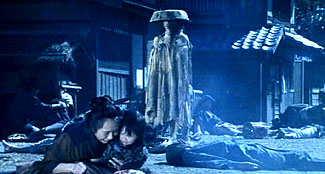 Sakuramaru (Masakatsu Funaki) is the orphaned bastard son of a rapist who has always been rejected by society. Sakuramaru (Masakatsu Funaki) is the orphaned bastard son of a rapist who has always been rejected by society.
If he's to be outcast anyway, he will live up to expectations. He likes to lie in wait in the forest & kill people, lots of people, as many as he can.
He's so strong & his fellow humans are so easily slain that he rather prefers to fight demons like Kibakichi, as there's more risk, thus more fun.
But when he encounters the wolf-girl Anju (Miki Tanaka in the only other reprised role, & never mind that she got killed in the first film), he becomes deeply enamored of her.
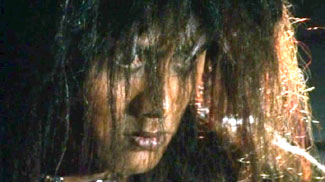 To her annoyance Sakuramaru becomes pesky & adoring, but he does turn out to be helpful when Anju turns the tables on those who would kill all yokai. To her annoyance Sakuramaru becomes pesky & adoring, but he does turn out to be helpful when Anju turns the tables on those who would kill all yokai.
The emotional attachment Sakuramaru develops for Anju makes him a very sweet & likeable character, despite that he kills randomly & bloodily. Though he's a crazed killer who takes lives without remorse, he's also the sort who would help a bug survive.
Anju the wolf-girl is from Kibakichi's slaughtered werewolf village & she carries a grudge against her brother. Anju dresses like Little Red Riding Hood which is distracting & foolish, but otherwise an interesting character with great martial ability.
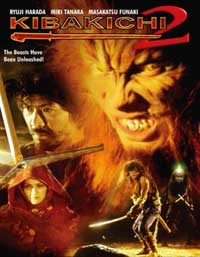 Although Kibakichi is deplored as a monster by the nearby village, & is not apt to be thanked for his efforts, he nevertheless feels a chivalrous compulsion to fight Sakuramaru who has been killing far too many people. Although Kibakichi is deplored as a monster by the nearby village, & is not apt to be thanked for his efforts, he nevertheless feels a chivalrous compulsion to fight Sakuramaru who has been killing far too many people.
Kibakichi gets injured in his first duel with Sakuramaru, & is afterward nursed back to health by a sweet blind girl (Aimi Nakamura).
She is later killed by the insane, supernatural demonslayer Dougan. Kibakichi will of course have to avenge blind Omatsu.
Dougan turns out to be himself a yokai monster, a one-horned oni devil whose horn glows in the dark. When his true form is revealed, he's pretty silly looking.
There's plenty of action -- indeed, there's little else but action -- until it comes time for the final duel between wolf-boy & wolf-girl.
There was no complete transformation until near the end of the final fight, when it is wolf vs wolf, but looks rather too much like a sasquatch disco event.
In all, the second installment of Kibakichi's adventures is even less inclined than the first to overcome its own silliness. It is nevertheless laughable good fun. Despite the film's expansive failings, Kibakichi simply looks cool-cool-cool in his ratty-ass wanderer's cape & worn-out sedgehat.
For more "Yokai" fantasy films, see also:
The Yokai Monsters Trilogy (1968-69)
Or for more werewolf films, continue to:
Underworld (2003) and Underworld: Evolution (2006)
copyright © by Paghat the Ratgirl
|
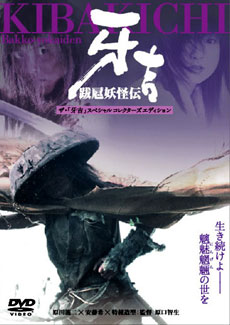

 There would have been more strength to this film if Kibakichi retained the wanderer costume & had done mortal battle against yakuza, samurai, & demons.
There would have been more strength to this film if Kibakichi retained the wanderer costume & had done mortal battle against yakuza, samurai, & demons. Putting the chief bad guys in Matrix leather coats likewise throws the viewer out of the tale with big reminders that this is just a dumb corny film for cheerful dunderheads too drunk to care if stories make sense or not.
Putting the chief bad guys in Matrix leather coats likewise throws the viewer out of the tale with big reminders that this is just a dumb corny film for cheerful dunderheads too drunk to care if stories make sense or not.
 The ultimate film about such wanderers is Kon Ichikawa's 1973
The ultimate film about such wanderers is Kon Ichikawa's 1973  Such is the nature of brave, skillful Kibakichi, though the wanderers of Kon Ichikawa's film were more realistic thus neither skillful as fighters nor lucky as gamblers.
Such is the nature of brave, skillful Kibakichi, though the wanderers of Kon Ichikawa's film were more realistic thus neither skillful as fighters nor lucky as gamblers. Films about Yokai are a genre unto themselves that go back to beginnings of Japanese cinema, & had their first big rage of popularity in the 1950s & 1960s of black & white kaidan (weird) & yokai (demon) movies.
Films about Yokai are a genre unto themselves that go back to beginnings of Japanese cinema, & had their first big rage of popularity in the 1950s & 1960s of black & white kaidan (weird) & yokai (demon) movies.
 Sakuramaru (Masakatsu Funaki) is the orphaned bastard son of a rapist who has always been rejected by society.
Sakuramaru (Masakatsu Funaki) is the orphaned bastard son of a rapist who has always been rejected by society. To her annoyance Sakuramaru becomes pesky & adoring, but he does turn out to be helpful when Anju turns the tables on those who would kill all yokai.
To her annoyance Sakuramaru becomes pesky & adoring, but he does turn out to be helpful when Anju turns the tables on those who would kill all yokai.